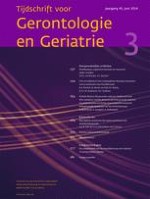01-06-2014
CVA-revalidatie in het verpleeghuis: therapie-intensiteit van en motivatie voor fysiotherapie
Gepubliceerd in: Tijdschrift voor Gerontologie en Geriatrie | Uitgave 3/2014
Log in om toegang te krijgenStroke rehabilitation in nursing homes: intensity of and motivation for physiotherapy
Introduction
Stroke is a frequent and potential invalidating disease, of which recovery can be improved by rehabilitation. In The Netherlands old and frail stroke patients are rehabilitated in nursing homes. Probably, the intensity of and motivation for physiotherapy are important for successful discharge. The aim was to determine (1) therapy intensity of and motivation for physical therapy of geriatric stroke patients (2) its correlates and (3) the effect on discharge destination.
Methods
Data were obtained from the ‘GRAMPS’-study, a longitudinal observational study of stroke rehabilitation in 15 Dutch nursing homes. Direct time spent on physiotherapy was registered during admission. Motivation was measured by the Pittsburgh Rehabilitation Participation Scale (PRPS). Data of 84 patients were analysed using uni- and multivariate regression analysis.
Results
Patients received an average 109 min of physiotherapy per week. 69 patients (82%) were good motivated for physiotherapy (had all PRPS scores 4 or higher). Therapy intensity was positively associated with the presence of a partner and good motivation. No significant independent variables of motivation were found. Therapy-intensity was positively related to discharge to prior living situation.
Conclusion
Intensity of physiotherapy of stroke rehabilitation is an independent variable of successful discharge and is higher when the patient has a partner or is better motivated. These findings stress the importance of high motivation and therapy intensity in geriatric stroke rehabilitation.
